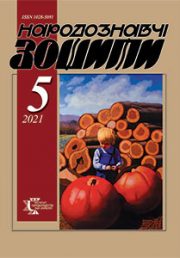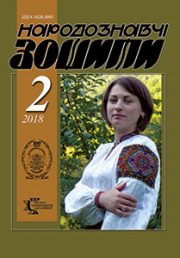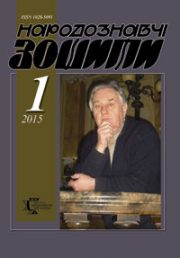The Ethnology Notebooks. 2019, 1 (145), 41—47
UDK 745/749 : 7.02
DOI https://doi.org/10.15407/nz2019.01.041
DIFFICULTIES OF TRANSLATION: BETWEEN «ETHNIC» AND «DESIGN»
LEBEDIEVA Alona
ORCID ID: https://orsid.org/0000-0002-4583-8195
Postgraduate student, Kiev National University of Culture and Arts,
36, Evgeni Konovalets str., 01133, Kyiv, Ukraine
Contacts: e-mail: goshalebedev@gmail.com
Abstract. «Ethno-Design» is a very popular notion in the specialized Ukrainian literature of our days. Behind the frequency of its use attempts are being made to impart «ethnic coloring» to modern samples of clothing, print, the interior design etc. However, keeps the uncomfortable question: is design possible in the current conditions of Ukrainian industry? In the form of a compensatory mechanism, a kind of «dictionary» appears for the folk art translation into the language of design. Will not the desire for national «recognition» lead to the next after 1940-50s «neo-adornment» trend, whimsically connected with cultural traditions, when the design is burdened by a sign layer alien to it, and the work itself (thing) is burdened with its inherent fictitious function?
Keywords: design, ethno- design, decorative arts, function, thing.
Received 24.12.2018
REFERENCES
Gumilev, L. (1994). Konec i vnov nachalo. Moskva [in Russian].
Gumilev, L. (1970). Etnogenez i etnosfera. Priroda, 1, 10—43 [in Russian].
Genon, R. (2005). Vostok i Zapad. Moskva. Retrieved from: http://www.fatuma.net/text/guenon-vostok-i-zapad.pdf (data zvernennya: 02.09.2018) [in Russian].
Kepeschuk, P. (2004). Suchasni problemy v meblevomu vyrobnytstvi. Mystetstvoznavstvo’04 [in Ukrainian].
Rudenchenko, A. (2013). Metodolohichni osnovy navchannia etnodyzajnu u vyschykh mystets’kykh navchal’nykh zakladakh. Visnyk Chernihivs’koho natsional’noho pedahohichnoho universytetu, 110, 278—281 [in Ukrainian].
Video-lektsiia Deyan Sudzhich: Yazyk veshej. Retrieved from: https://vimeo.com/24164410 [in Russian].
Baudrillard, J. (1995). Sistema veshej. Moskva: Rudomino [in Russian].
Yurchenko, I. (2015). Aktual’ni hrani etnomystets’koi tradytsii v dyzajn-diial’nosti. Etnodyzajn: ievropejs’kyj vektor rozvytku i natsional’nyj kontekst (Kn. 3, pp. 94—98) [in Ukrainian].
Svirko, V.O. (Ed.). (2009). Slovnyk z dyzajnu i erhonomiky. 2-he vyd. Kyiv: NTMT [in Ukrainian].
Yurchenko, I. (2014). Syntez ornamental’nosti j minimalizmu v stylistytsi etnodyzajnu. Mystetstvoznavstvo’14 [in Ukrainian].
Kryzhanivs’kyj, O. (2012). Teoretychne osmyslennia kul’turno-istorychnoi spadschyny naselenykh punktiv Ukrainy v konteksti staloho prostorovoho rozvytku Yevropy. Istoryko-kul’turna spadschyna Dniprovs’koho Livoberezhzhia, Kurs’koho Posejm’ia ta Slobozhanschyny: mynule i suchasnist’: Zbirnyk materialiv mizhnarodnoi naukovo-praktychnoi konferentsii, prysv. 285-richchiu obrannia Danyla Apostola het’manom Livoberezhnoi Ukrainy (m. Hlukhiv, 24 liutoho 2012). Hlukhiv; Nizhyn, 2012 [in Ukrainian].
Scho zabezpechylo peremohu ukrains’kykh dyzajneriv na Paryz’komu tyzhni dyzajnu? Interv’iu. Retrieved from: https://www.youtube.com/watch?v=SMyF8TDzrg&t=963s (data zvernennia: 29.09.2018) [in Ukrainian].
Stankevych, M. (1999). Narodne mystetstvo i dyzajn: lohika osnovnykh rivniv formotvorennia. Mystetstvoznavstvo’99 (pp. 65—70) [in Ukrainian].
Stankevych, M. (2004). Utylitarnist’ dekoratyvnoho mystetstva. Mystetstvoznavstvo’04 (pp. 9—17) [in Ukrainian].
Bodnar, O. (2000). Peredumovy i deiaki aktual’ni problemy rozvytku dyzajnu v Ukraini. Mystetstvoznavstvo’2000 (pp. 45—52) [in Ukrainian].
Bozhko, T. (2013). Etnichna symvolika u masovij kul’turi: problemy ta naslidky zastosuvannia. Aktual’ni problemy istorii, teorii ta praktyky khudozhn’oi kul’tury, 31, 104—111 [in Ukrainian].
Bodnar, O. (2005). Aktual’ni problemy suchasnoi teorii dyzajnu. In Suchasni problemy doslidzhennia, restavratsii ta zberezhennia kul’turnoi spadschyny (Vyp. 2, pp. 22—28) [in Ukrainian].
Kardash, O., & Luhantseva, D. (2014). Styl’ovi oznaky natsional’noho v ukrains’komu dyzajni. Teoriia ta praktyka dyzajnu, 6, 54—60 [in Ukrainian].
Tatiivs’kyj, P. (2002). Priorytetni zadachi vitchyznianoho dyzajnu na suchasnomu etapi joho stanovlennia. Tekhnichna estetyka i dyzajn (Vyp. 2, pp. 9—12) [in Ukrainian].
Svirko, V., & Rubtsov, A. (2012). Priorytetni napriamky rozvytku natsional’noho dyzajnu. Teoriia ta praktyka dyzajnu, 1, 13—26 [in Ukrainian].
Yurchenko, I. (2001). Problema natsional’nykh tradytsij v suchasnij dyzajn-diial’nosti. Mystetstvoznavstvo’01 (pp. 141—154) [in Ukrainian].







